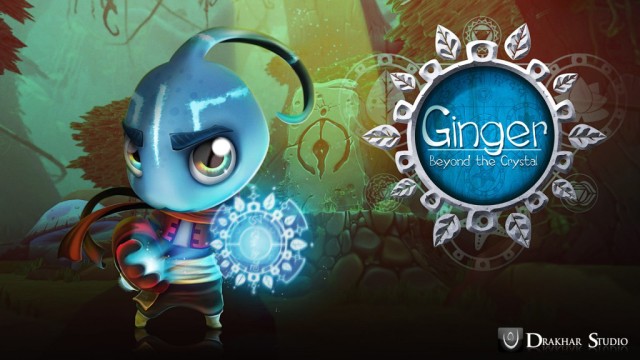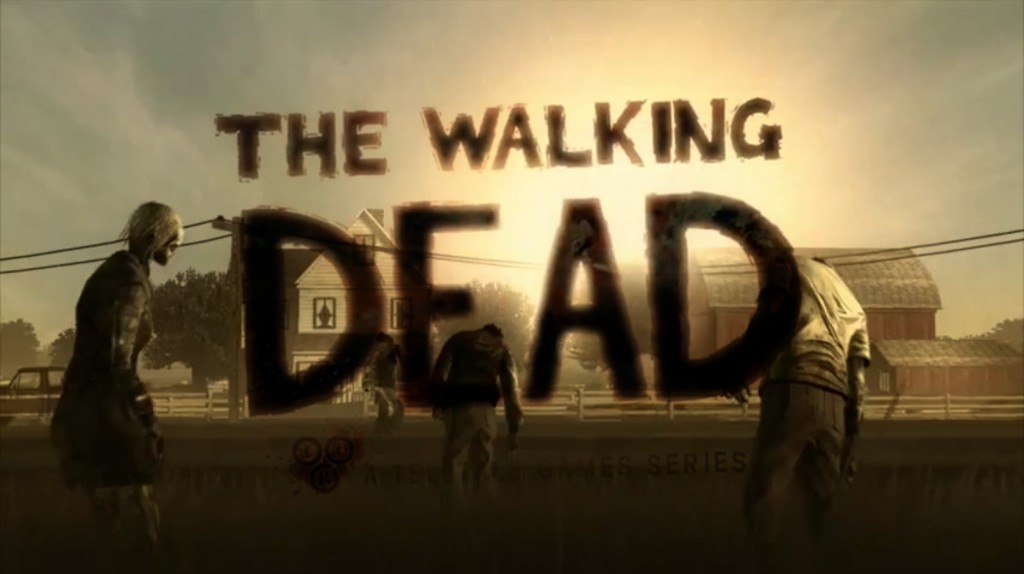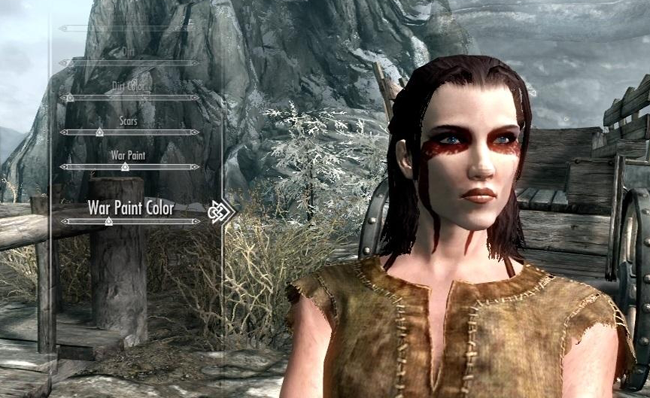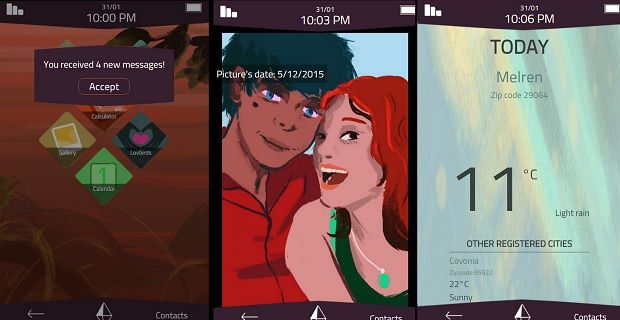Since we’ve been discussing Her Story again lately, I went back and replayed the beginning. The game initially seeds the player with four videos tagged with the keyword “murder,” and since the gameplay is built solely from searching keywords, I catalogued all the major options in these early videos, omitting articles and repeated words, and organizing them by color of the character’s outfit:
| Red | Blue | White 1 | White 2 |
| help | me | wrong | lawyer |
| February | person | please | |
| month | weapon | ||
| Simon | nothing | ||
| murder | stories | ||
| telling |
By tracking these initial words, we can clearly see a few routes the game is encouraging us toward with the keywords. We can follow facts — Simon (the victim), weapon, February, or we can search for more abstract clusters by looking into stories, telling, maybe even nothing. Each decision will reveal different parts of the story and lead us down diverging paths of keywords. But players used to mysteries or the dozens of police procedurals that have dominated television for decades might take a different tactic, by choosing weapon and Simon, for instance, but also looking for words like motive and evidence. And then there are different paths altogether; when I initially played, I tracked names first, as I wanted to assemble an idea of the people involved in this crime. I started with Simon and then tracked other names as they were mentioned: Hannah, Eve, Helen. Only after I ran out of names did I look in any other direction (and by then, for me, it was stories).
How might my game have differed if I’d chosen a different route? How does the game itself change based on the player?
We’ve spent much time talking about Life Is Strange as that game’s episodes have been released because it’s closer a Beyond: Two Souls experience than a Telltale experience, with choices that create a divergent narrative. Characters can die or not in Life Is Strange, just as events can happen, or not, in Beyond, and while some of that happens in contemporary Telltale games, the narrative stays largely the same. It can be argued the same is true for Life Is Strange, but it certainly feels different when one player can visit a character in a hospital, but in another player’s game, that character is dead. These are the more overt ways the game can change from episode to episode, but players also have a chance to develop relationships with tertiary characters that are changeable, and have some influence on Max’s sexuality. In these ways, players can take ownership, molding the game to their own preferences.
In Jim Gee’s book What Video Games Have to Teach Us About Learning and Literacy, he spends a good portion of a chapter discussing Tomb Raider: The Last Revelation, and how the game encourages players to diverge from instructions they are given in-game by Lara Croft’s mentor, Von Croy. Von Croy, in a tutorial section, delivers specific instructions, but players who circumvent these and explore more freely are rewarded with hidden treasure. Gee uses this to talk about learning and challenging standards, but there’s something else here, too: that players create different narratives simply by acting. The game paints Lara as a snappy, snarky teenager and encourages physical actions in keeping with that, but a player who follows instructions creates a different Lara, a Lara who is all bark on the surface but who, deep down, respects authority. Games are full of these tiny divergences and moments of player choice, particularly open world games. Players who power through the main story first and then turn to side quests create entirely different worlds — and different games — than those who ignore the main quest and gallivant off into the wilds to do whatever, and players who mix it up have yet other experiences.
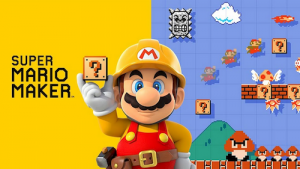 Lately, I’ve been hearing a lot of people talk about Super Mario Maker, which I don’t have, but which I’m learning much about from videos and descriptions of created levels. Maybe it’s because I’m surrounded by the nerdiest of nerds in my scholarly bubble of games studies, but the discussions of enemy placement and tactics has been immersive and constant since that game’s release, and it’s made me rethink my fascination with choices in gaming. Is it just that we are rebellious and want to leave a mark on our experiences, or does the popularity of Super Mario Maker reveal something else: that we want to push up our sleeves and get about the business of really creating? Not everyone can makes games, after all; sure, yes, there are now tools that make creation much easier, but we’re not all rolling out AAA titles in our sleep. But just as we’re pulling recipes off Smitten Kitchen for our own kitchens, and attempting clever DIYs seen on Pinterest, there is that part of us that thrills at the idea of creating levels for an experience many of us grew up with. We all know the inner workings of Mario games as intimately as we know sugar to flour ratios, or how to count stitches, or how to select the proper audio format for a particular band or song for the purest experience — in other words, as intimately as we know any of our other hobbies. Super Mario Maker was always going to be a universal win.
Lately, I’ve been hearing a lot of people talk about Super Mario Maker, which I don’t have, but which I’m learning much about from videos and descriptions of created levels. Maybe it’s because I’m surrounded by the nerdiest of nerds in my scholarly bubble of games studies, but the discussions of enemy placement and tactics has been immersive and constant since that game’s release, and it’s made me rethink my fascination with choices in gaming. Is it just that we are rebellious and want to leave a mark on our experiences, or does the popularity of Super Mario Maker reveal something else: that we want to push up our sleeves and get about the business of really creating? Not everyone can makes games, after all; sure, yes, there are now tools that make creation much easier, but we’re not all rolling out AAA titles in our sleep. But just as we’re pulling recipes off Smitten Kitchen for our own kitchens, and attempting clever DIYs seen on Pinterest, there is that part of us that thrills at the idea of creating levels for an experience many of us grew up with. We all know the inner workings of Mario games as intimately as we know sugar to flour ratios, or how to count stitches, or how to select the proper audio format for a particular band or song for the purest experience — in other words, as intimately as we know any of our other hobbies. Super Mario Maker was always going to be a universal win.
But that is overt creation; we know we are making something in that game (it’s in the title!). When we are choosing keywords in Her Story, or taking off for a side quest in Skyrim, we aren’t thinking necessarily about creation, but simply following wherever our desires may lead us. When we are thinking about it, as with something like Super Mario Maker, though, we are probably thinking more in terms of mechanics, not about how the world or story changes when we place certain objects, because, let’s face it, the “story” of Mario is not particularly deep. But how are we impacted by our choices? When we watch Let’s Plays, are we watching, in some ways, to experience someone else’s narrative? Someone else’s game, built to their specifications? With games like the recent Until Dawn, that may be the case, but again, that’s a more overt scenario, and what intrigues me are the motives and drives that we’re not sure about, the things we do without thinking, the games and worlds we create on accident, just by existing in that space. This is probably why I continue to be so fascinated with Beyond, since much of that game’s choices are hidden, but it’s what keeps bringing me back to exploring the ways we build games without thinking, and without purpose.

